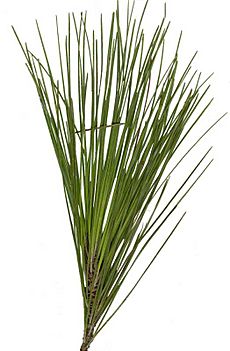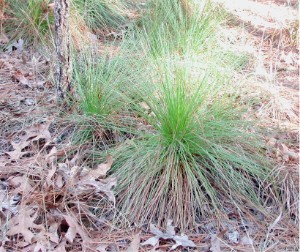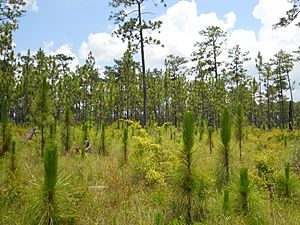Longleaf pine facts for kids
Quick facts for kids Longleaf pine |
|
|---|---|
 |
|
| Longleaf pine (Pinus palustris) forest | |
| Conservation status | |
| Scientific classification | |
 |
The longleaf pine (Pinus palustris) is a type of pine tree. It grows naturally in the Southeastern United States. You can find it along the coast from East Texas to southern Maryland, and also in northern and central Florida.
These trees can grow very tall, usually about 30 to 35 meters (100 to 115 feet) high. Their trunks can be about 0.7 meters (28 inches) wide. Long ago, before many were cut down, some longleaf pines were even taller, reaching 47 meters (154 feet) with trunks 1.2 meters (47 inches) wide! This tree is an important symbol of the Southern United States. It is the official state tree of Alabama. Many people think it's also North Carolina's state tree, but that's not quite right.
Contents
What it Looks Like
The bark of the longleaf pine is thick and reddish-brown. It looks scaly, like armor. Its leaves are dark green and shaped like needles. They usually grow in bundles of three, but sometimes you might see two or four together, especially on young trees. These needles are often twisted and can be very long, from 20 to 45 centimeters (8 to 18 inches). The longleaf pine is one of only two pines in the Southeastern U.S. with such long needles. The other is the slash pine.

The tree produces both male and female cones. Male cones, which make pollen, are about 3 to 8 centimeters (1 to 3 inches) long. Female cones, which grow seeds, take about 20 months to become fully grown after pollination. When they are ready, they are yellow-brown and quite large, about 15 to 25 centimeters (6 to 10 inches) long. They open up to about 12 centimeters (5 inches) wide. Each scale on the cone has a small, sharp point. The seeds inside are small, about 7 to 9 millimeters (0.3 to 0.4 inches) long, with a wing that helps them fly in the wind.
How it Grows
Longleaf pines grow slowly. It takes 100 to 150 years for them to reach their full size. They can live for a very long time, sometimes up to 500 years! When they are young, they grow a long main root called a taproot, which can be 2 to 3 meters (7 to 10 feet) deep. As they get older, their roots spread out wide, with some deeper "sinker" roots. These trees like to grow in sandy, well-drained soil. They often grow together in groups of only longleaf pines.
The scientific name for the longleaf pine is Pinus palustris. The word palustris means "of the marsh" in Latin. This name was given by Philip Miller, who first described the tree. He might have seen longleaf pine forests that had temporary flooding in winter, which made him think they grew in marshes.
Where it Lives

Longleaf pines are very good at surviving wildfires. Their thick bark helps protect them from the heat. Natural wildfires often help these trees by burning away other plants. This creates open longleaf pine forests or savannas where they can thrive.
When a longleaf pine first sprouts, it doesn't look like a tree at all. It looks like a dark-green bunch of needles, like a fountain. This is called the "grass stage." During this stage, which can last 5 to 12 years, the tree grows very slowly upwards. It might stay ankle-high for many years. After this stage, it grows very quickly, especially if there are no other trees blocking its sunlight. In the grass stage, the tree is very safe from small fires because its growing tip is protected by the tightly packed needles. However, young longleaf pines can be eaten by feral pigs.
Longleaf pine forests are home to many different kinds of plants and animals. They have a lot of plant diversity, including many types of grasses, sedges, and even carnivorous plants and orchids. These forests are also important homes for gopher tortoises. Gopher tortoises dig burrows that provide shelter for hundreds of other animal species. The red-cockaded woodpecker also depends on old longleaf pine forests. This bird is now endangered because so many of these forests have been lost.
The large, nutritious seeds of the longleaf pine are a good food source for birds, like the brown-headed nuthatch, and other wildlife. Many salamanders, frogs, and reptiles also live in these pine savannas.
Some of the best longleaf pine forests that are still around are in the Red Hills Region of Florida and Georgia. These forests have been regularly burned for a long time to help create good habitat for bobwhite quail on private hunting lands.
What it's Used For
Long ago, huge forests of longleaf pine covered the southeastern Atlantic and Gulf Coasts of North America. These forests were very important for "naval stores." This means they provided resin, turpentine, and timber for building and maintaining ships.
Over time, most of these forests were cut down for timber. Often, faster-growing pines like loblolly pine and slash pine were planted in their place. Land was also cleared for agriculture and for building cities and towns. Because of all this cutting, only about 3% of the original longleaf pine forests are left today. Not many new ones are being planted, either. However, you can still buy longleaf pine trees at many plant nurseries in the areas where they naturally grow.
The wood of the longleaf pine is yellow and full of resin. It is used for lumber and pulp (which is used to make paper). Boards cut from very old, original longleaf pines years ago were very wide, sometimes up to 1 meter (3 feet). Today, there's a business that finds these old boards from buildings being torn down. They are then reused as beautiful flooring in fancy homes.
The very long needles of the longleaf pine are also popular for making traditional coiled baskets.
The stumps and deep roots of old longleaf pines are full of resin and don't rot easily. Farmers sometimes find these old stumps buried in fields, even fields that were cleared a hundred years ago! These stumps are often dug up and sold as "fatwood" or "lighter wood." People use them as kindling to start fires in fireplaces, wood stoves, and barbecue pits because they burn very well. The inner wood of the tree trunk can also be full of resin. Boards cut from this "fat lighter wood" are very heavy and won't rot, but they are also very flammable.
The seeds of the longleaf pine can be eaten raw or roasted.
A Special Tree
The longleaf pine is the official state tree of Alabama. Many people in North Carolina believe it is their state tree, too. This is probably because it's mentioned in the first line of the official North Carolina State Toast. Also, North Carolina's highest honor is called the "Order of the Long Leaf Pine". However, the state tree of North Carolina is officially just "pine," not a specific type of pine.
Protecting the Longleaf Pine
Before Europeans arrived, longleaf pine forests covered a huge area, about 90 million acres (364,000 square kilometers), from Virginia to Florida and west to East Texas. These forests thrived because of frequent wildfires that swept through the Southeast. In the late 1800s, these untouched forests were highly valued for their timber.
Sadly, these rich forests were almost completely destroyed by clear-cutting. This is when all the trees in an area are cut down. After logging, a lot of leftover wood and branches were left behind. This debris often caused huge, damaging fires that destroyed any remaining trees and young seedlings. The bare ground left after clear-cutting also led to a lot of soil erosion, washing away important nutrients. This made it hard for new seeds to grow naturally. By the 1920s, most of the "limitless" longleaf pine forests were gone.

Today, many groups are working to bring back the longleaf pine ecosystems. Organizations like the Longleaf Alliance are helping with research, education, and managing these forests.
The USDA offers help to private landowners who want to restore longleaf pines on their land. Most state forestry agencies in the longleaf's natural range also have similar programs. For example, in 2009, the Alabama Forestry Commission received money to restore longleaf pines in state forests.
There are four large areas where efforts are focused on protecting and restoring longleaf pine forests. These include Eglin Air Force Base, Apalachicola National Forest, Okefenokee-Osceola, and De Soto National Forest. These areas are important for bringing back not only the forests but also the animals that depend on them.
Some special groups of longleaf pines still exist in the Uwharrie National Forest in central North Carolina. They survived because they were hard to reach, and one area was even protected by a private landowner.
The United States Forest Service is using controlled burns in the Francis Marion National Forest in South Carolina. They hope to increase the amount of longleaf pine forest there. These controlled fires also help the endangered red-cockaded woodpecker and reduce the risk of bigger, damaging wildfires.
Since the 1960s, longleaf pine restoration has been happening in the sandhills region of South Carolina. This area has sandy, less fertile soil. Most of the native longleaf pines were logged by the 1930s, and the land was badly eroded. Today, parts of this area are protected as the South Carolina Sand Hills State Forest and the Carolina Sandhills National Wildlife Refuge. Controlled fires are now used to help restore the longleaf pine and wiregrass ecosystem.
Nokuse Plantation in Florida is a large private nature preserve. It was created by M.C. Davis, who spent a lot of money buying land to protect it. One of its main goals is to restore the longleaf pine forest. Millions of longleaf pine seedlings have been planted there.
A study in 2009 suggested that longleaf pine forests might be especially good at adapting to changes caused by climate change.
Images for kids
See also
 In Spanish: Pino de hoja larga para niños
In Spanish: Pino de hoja larga para niños








